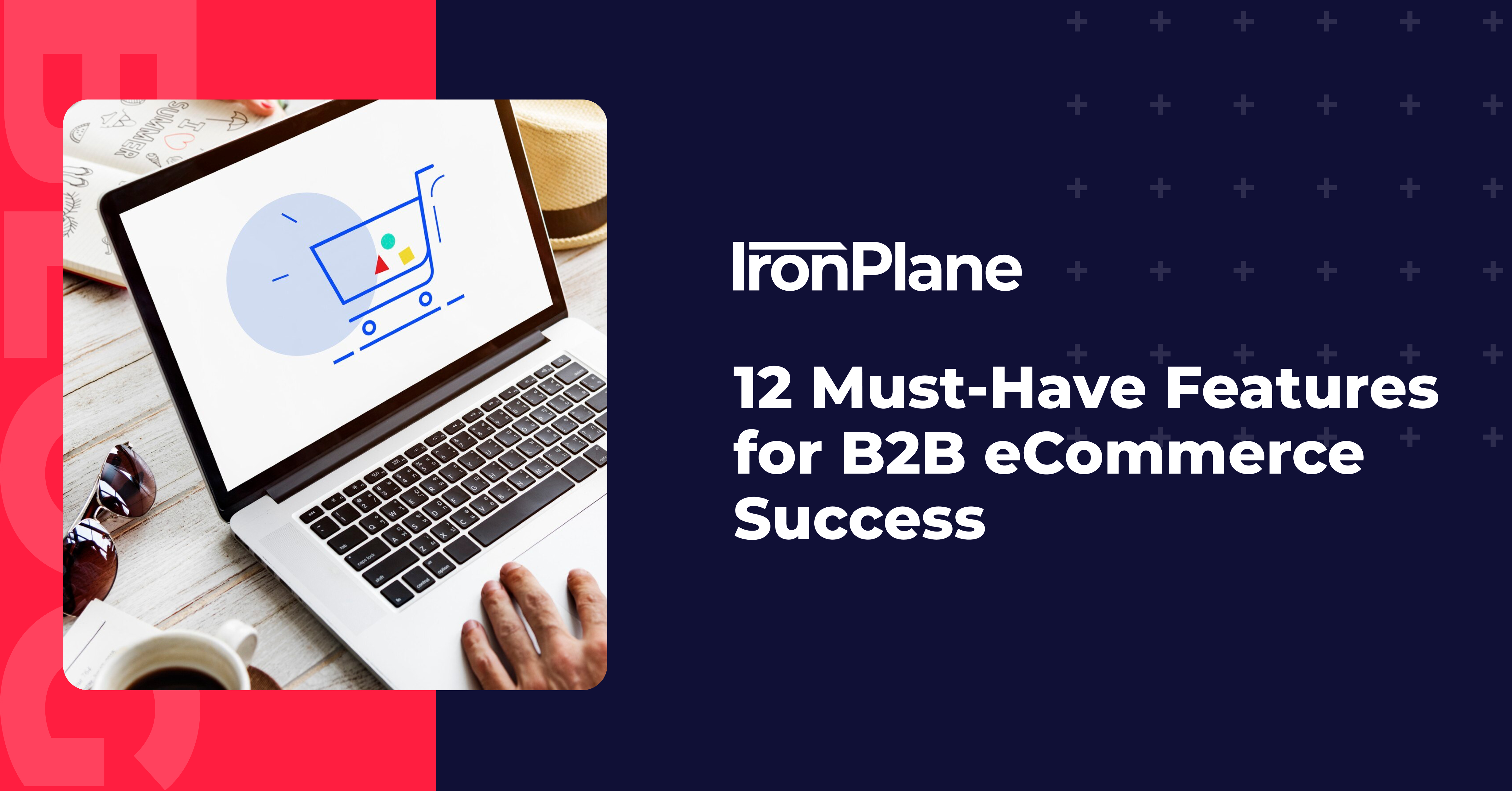12 Must-Have Features for B2B eCommerce Success
B2B eCommerce websites are changing how businesses work together. At IronPlane, we know what makes a good B2B eCommerce platform. We've found 12 key features that can help your B2B website do well.

Key performance indicators (KPIs) serve as the compass guiding eCommerce businesses through the complex landscape of online sales. In this article, we'll delve into 13 critical B2B eCommerce KPIs, offering in-depth insights into their definitions, measurement methods, and tracking frequencies.
Here are the 13 B2B eCommerce metrics you’ll want to track to keep your business ahead of the competition, along with suggestions for tracking frequency and more.
Related Read: eCommerce CRO Audit Guide: How to Get Clear & Actionable Insights
Conversion rate is a fundamental metric that gauges the efficiency of a website in turning visitors into customers. This KPI provides a snapshot of the site's effectiveness in driving sales. It is recommended to track this metric daily and weekly for trends and conduct more in-depth monthly analyses. Per Shopify, average eCommerce conversion rates hover around 2.5% to 3% — these figures can make a good baseline expectation if you’re just getting started.
While conversion rate indicates the effectiveness of your website in turning visitors into customers, it doesn't provide insights into the quality of those conversions. Monitor other metrics like AOV and customer retention to get a more holistic picture.
Customer acquisition cost is the expenditure associated with gaining a new customer. By dividing your total marketing and sales expenses by the number of new customers, you can determine the cost incurred to bring in each new client. Tracking CAC on a monthly and quarterly basis aids in strategic decision-making, helping businesses assess the efficiency of their acquisition strategies.
It’s worth noting that CAC alone doesn't reveal the long-term value of acquired customers. Pair it with CLV to ensure that your acquisition costs are justified by the revenue generated over the customer's lifespan.
Average order value represents the average amount spent by customers in a single transaction. Monitoring AOV on a weekly and monthly basis enables businesses to identify shifts in purchasing behavior and tailor strategies accordingly.
Having a high AOV might be impressive, but it also doesn't guarantee profitability. Assess the balance between AOV and CAC to ensure that higher spending is translating into sustainable profits.
Your customer retention rate indicates the percentage of customers retained over a specific period. This KPI offers insights into the success of ongoing customer relationship efforts. Regular monthly and quarterly tracking helps businesses assess the effectiveness of their loyalty-building strategies.
While retention rate highlights loyalty, it doesn't guarantee active engagement. Be sure to track customer activity — such as repeat purchases and feedback — to measure true customer satisfaction and loyalty.
Inventory turnover is the number of times inventory is sold and replaced within a given period. By dividing the cost of goods sold by the average inventory value, you can optimize your business’ inventory management. Monitoring this KPI monthly — and seasonally — ensures a balanced approach to turnover without risking stockouts. Balance turnover with safety stock levels to ensure consistent product availability.
Cart abandonment rate reflects the percentage of users who add items to their cart but do not complete their purchase. This KPI requires both daily and weekly monitoring to address immediate concerns and enhance the conversion process.
Cart abandonment can be a result of multiple factors, including high additional costs (taxes, shipping, etc.), forced account creation, lengthy checkout processes, and more. Analyze user behavior and implement strategies like retargeting and personalized offers to recover potentially lost sales. According to Baymard Institute, the average cart abandonment rate is nearly 70% for shoppers — making this metric among the highest priorities to track.
Your website traffic sources signify the origin of site visitors — these sources include direct, organic, and paid search. Analyzing this KPI on a weekly basis allows businesses to optimize marketing strategies, ensuring a targeted approach to different traffic channels.
Remember, traffic sources alone don't reveal the quality of visitors. Analyze the conversion rates from different sources to identify the most valuable channels and optimize your marketing spend accordingly.
Your lead-to-customer conversion rate measures the percentage of leads that result in paying customers. Businesses should track this KPI monthly to refine lead generation efforts and maximize conversion efficiency. Even if your conversion rates are high, it's essential to assess lead quality. Implement lead scoring to identify high-value leads and tailor your marketing efforts accordingly.
Return on investment gauges the profitability of marketing and advertising efforts. Monthly and quarterly tracking of this metric enables businesses to evaluate campaign effectiveness and optimize their marketing mix.
ROI provides an overall picture, but doesn't necessarily detail which specific channels are most effective. Dive deeper into individual campaign metrics to optimize your marketing mix.
The mobile conversion rate metric measures the percentage of mobile users who complete a purchase. Your business should track this KPI weekly or monthly to adapt to changing mobile user behavior and ensure an optimal mobile experience.
It’s worth noting that mobile conversion rates can be influenced by user experience. Regularly test and optimize your mobile site to enhance the conversion process for mobile users.
Related Read: Magento Site Optimization: 2023 Guide (With 5 Tips & Examples)
Customer lifetime value represents the total revenue a business can expect from a customer throughout their entire relationship. This KPI is calculated by multiplying the average purchase value, purchase frequency, and customer lifespan — we recommend quarterly and annual tracking to guide long-term strategic planning.
Reader Tip: CLV doesn't account for acquisition costs. Use CLV to guide your long-term strategy, but ensure that the cost of acquiring and retaining customers remains sustainable.
Bounce rate is the percentage of visitors who navigate away from the site after viewing only one page. According to Adobe, the average eCommerce site bounce rate was 43% last year — so we recommend weekly tracking to aid in identifying issues and improving website engagement for this pressing issue. Assess your landing pages, content, and user experience to reduce bounce rates.
You should always be tracking the effectiveness of your business’ shipping and order fulfillment processes. This KPI considers factors like order fulfillment time, shipping accuracy, and customer satisfaction. Regular monitoring ensures operational excellence and customer satisfaction — collect feedback and read customer reviews to ensure that your shipping and fulfillment processes align with customer expectations.
Selecting the right KPIs depends on factors like industry, business size, and unique business goals. Consider the following tips:
The best choice for tracking key B2B eCommerce metrics depends on your specific needs and priorities. Here are some factors to consider:
While your eCommerce platform of choice likely has analytics tools you can use to track your chosen metrics, third-party software can often yield deeper insights. Here are a few third-party tools we recommend.
Also Read: Magento 2 (Adobe Commerce) Advanced Reporting Guide
Google Analytics now often referred to as GA4 (Google Analytics 4) is a web analytics service that goes beyond just tracking website traffic. It offers in-depth insights into user behavior, conversion rates, and traffic sources. By setting up eCommerce tracking, your business can measure the performance of specific products and analyze user journeys — gaining a deeper understanding of your online presence.
Read More: Magento 2 and Google Analytics 4 Integration Guide
Tableau is a leading business intelligence tool that helps businesses visualize and analyze data. It can integrate with various data sources — including multiple eCommerce platforms and CRMs — providing a centralized hub for KPI reporting. Tableau's interactive dashboards enable your eCommerce team to explore trends and patterns in one place.
Optimizely is an experimentation platform that allows businesses to, as the name suggests, optimize their website and customer experience. With features like A/B testing and personalization, Optimizely helps businesses test different variations to determine the most effective strategies for improving key metrics. Integrating Optimizely into your toolkit can help ensure that any changes made are backed by data and contribute to your business objectives.
Harnessing the power of B2B eCommerce KPIs can provide a roadmap to sustained growth. Your business is likely inundated with data, so it pays to highlight some key metrics to focus your efforts on. Regularly assess and adjust your strategies based on the insights gained from these metrics, and you can begin to see measurable returns.

B2B eCommerce websites are changing how businesses work together. At IronPlane, we know what makes a good B2B eCommerce platform. We've found 12 key features that can help your B2B website do well.

Learn the eight B2B eCommerce strategies and tools you can use to propel your company towards success in the digital commerce marketplace.

Explore how to choose a B2B eCommerce platform using a solution alignment analysis, helping you make an informed decision for your business.